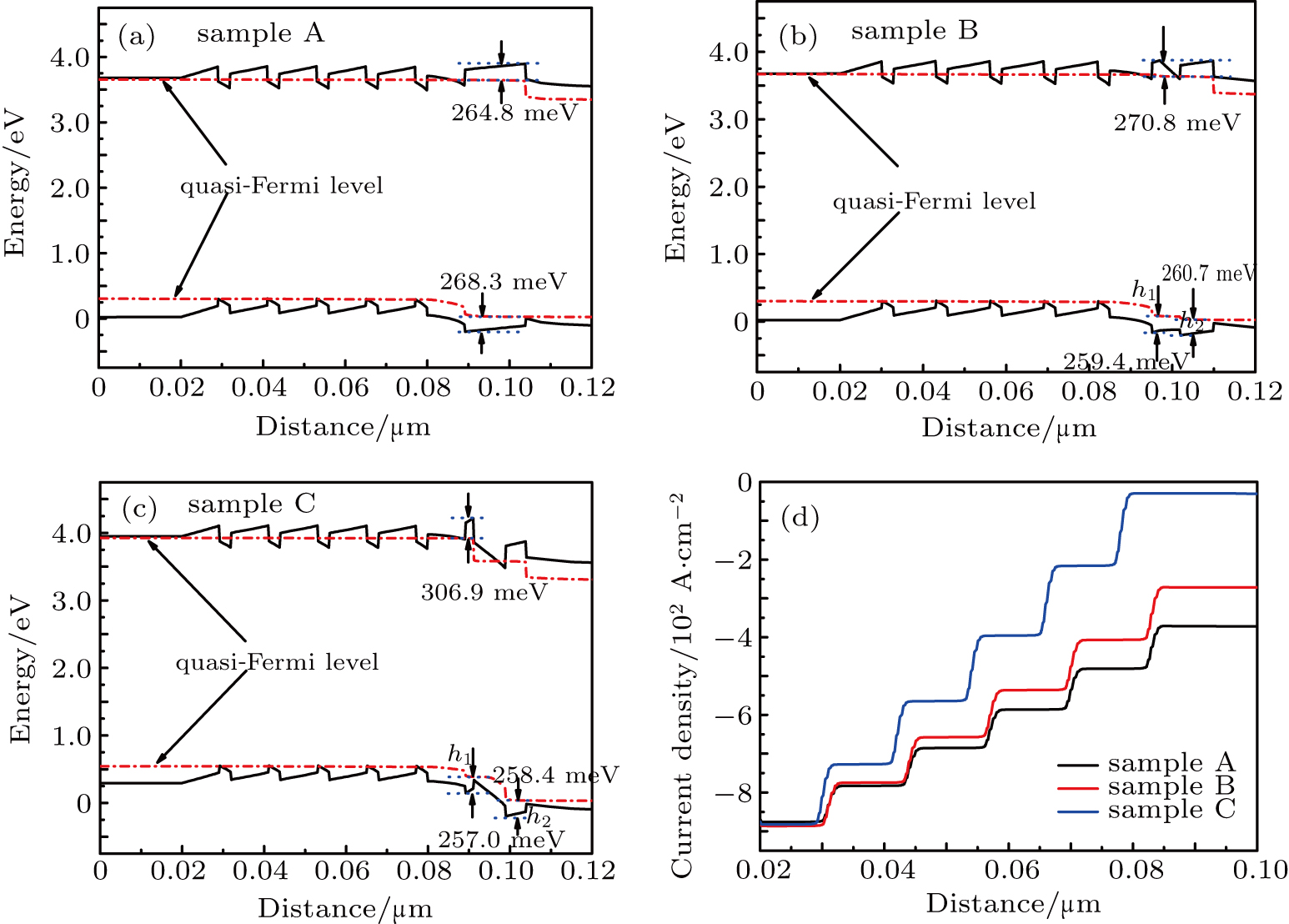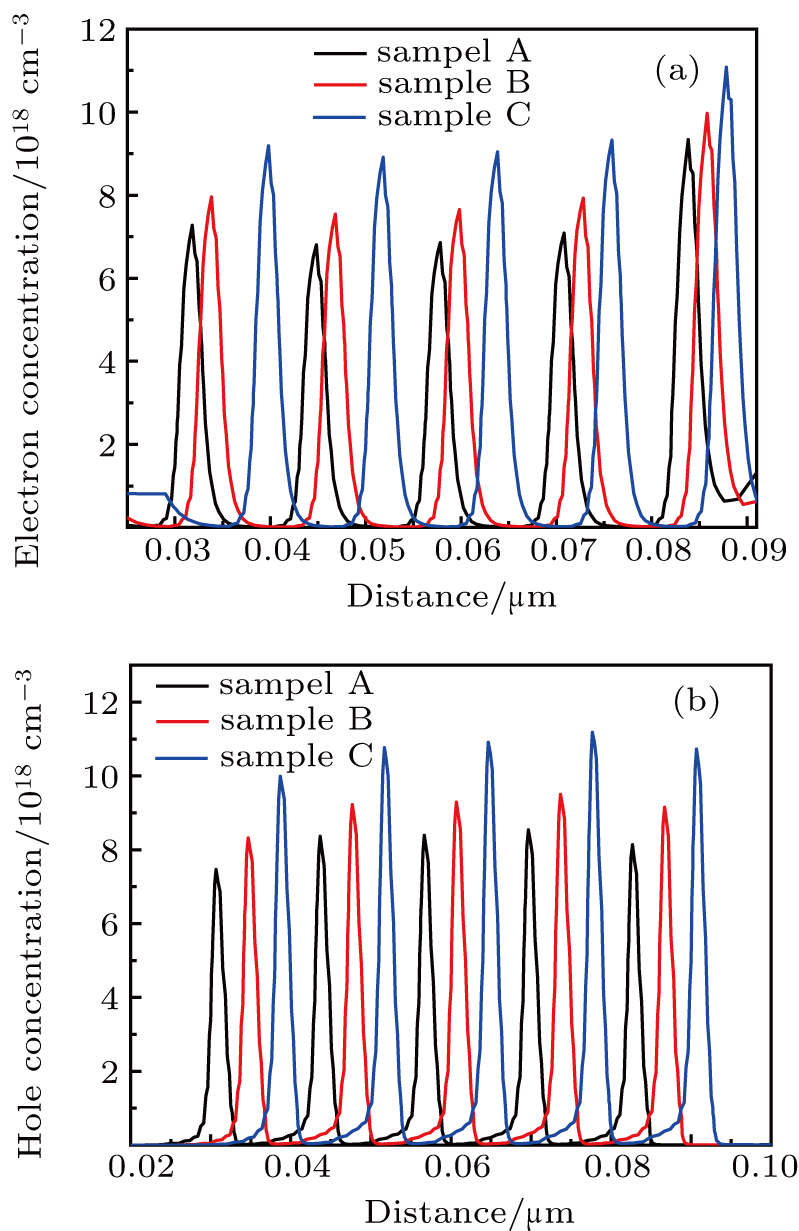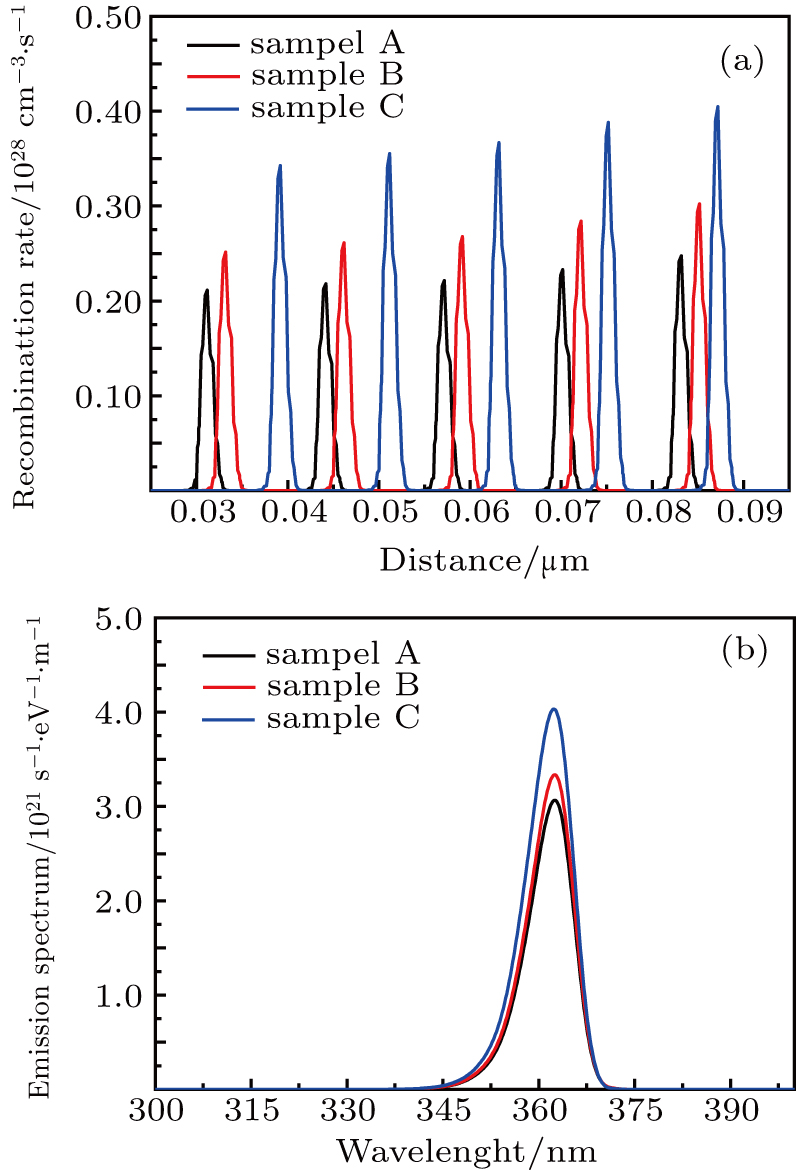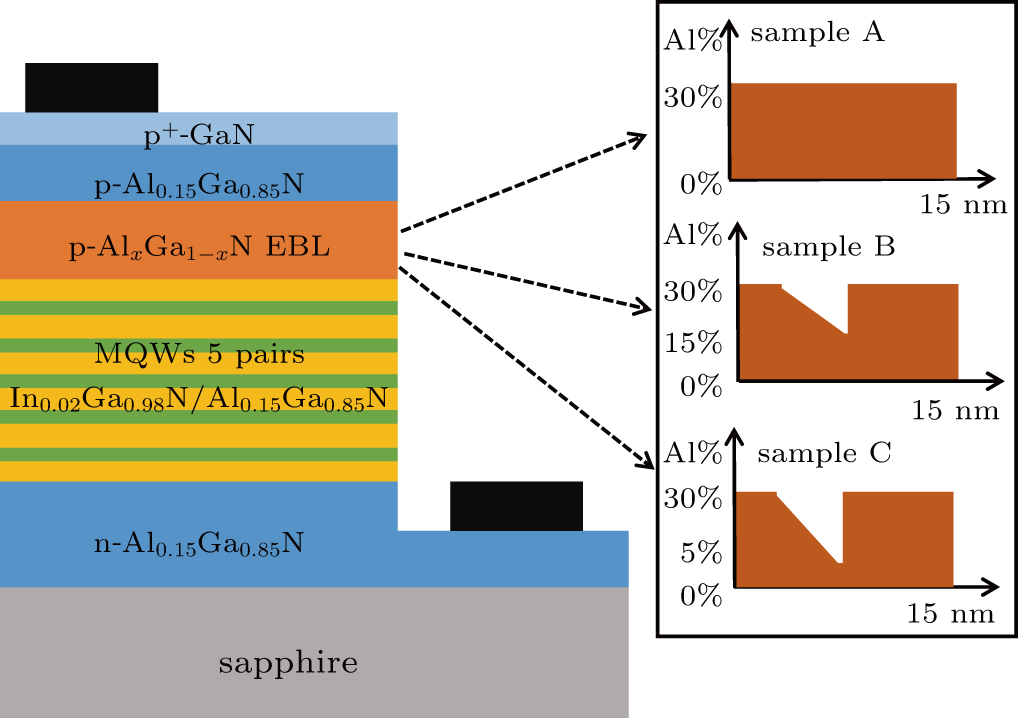† Corresponding author. E-mail:
The conventional stationary Al content AlGaN electron blocking layer (EBL) in ultraviolet light-emitting diode (UV LED) is optimized by employing a linearly graded AlGaN inserting layer which is 2.0 nm Al0.3Ga0.7N/5.0 nm AlxGa1−xN/8.0 nm Al0.3Ga0.7N with decreasing value of x. The results indicate that the internal quantum efficiency is significantly improved and the efficiency droop is mitigated by using the proposed structure. These improvements are attributed to the increase of the effective barrier height for electrons and the reduction of the effective barrier height for holes, which result in an increased hole injection efficiency and a decreased electron leakage into the p-type region. In addition, the linearly graded AlGaN inserting layer can generate more holes in EBL due to the polarization-induced hole doping and a tunneling effect probably occurs to enhance the hole transportation to the active regions, which will be beneficial to the radiative recombination.
The AlGaN-based ultraviolet light-emitting diodes (UV LEDs) have attracted great attention due to their wide applications, such as anti-counterfeiting recognition, air and water purification, chemical sensors, UV curing, and data storage.[1–3] In theory, the deep UV LEDs can be realized by increasing the aluminum composition in the quantum well. Nevertheless, the large activation energy of Mg in high Al content AlGaN layer and strong polarization induced electric field result in low hole concentration in the p-type AlGaN layer and serious electron leakage.[4] Consequently, the internal quantum efficiency (IQE) of the UV LEDs is far less than that of visible LEDs. In addition, the UV LEDs also face the problem of efficiency droop, the IQE of the UV LEDs obviously decreases at high current, which further restricts the commercial application of the UV LEDs. Some methods have been proposed to solve the above problems, such as adopting polarization-induced hole doping to enhance the hole concentration in p-type AlGaN,[5] designing a special electron blocking layer (EBL) to reduce electron leakage,[6–8] proposing special quantum well structures to depress the polarization effect in the active region.[9] In UV LEDs, a high Al content p-type AlGaN EBL is normally used to enhance the restriction of electrons and reduce electron leakage to the p-type layer.[10] However, it also creates a hole potential barrier in the valence band, which causes a low hole injection efficiency. On the other hand, the p-type AlGaN layer with high Al content is hardly realized due to the large activation energy of Mg, which also results in a low hole injection efficiency and a poor performance. Accordingly, researchers have put forward some new EBL structures to further improve the carrier injection, such as the polarization-reversed[11] or polarization-reduced[12] AlInGaN EBL, a gradually decreasing Al-content AlGaN EBL,[13] an inverted-V-shaped graded Al composition EBL,[14] and a p-AlInN/AlGaN superlattice EBL.[15] In this work, we numerically investigate and theoretically study the influence of a linearly graded AlGaN inserting layer in EBL on the performance of AlGaN-based UV LEDs. We find that the LED with the linearly graded AlGaN inserting layer in EBL shows markedly improved light output power and mitigated efficiency droop compared to that with the conventional stationary Al content AlGaN EBL. Further research shows that these improvements are attributed to the enhanced hole injection efficiency and the suppressed electron overflow simultaneously due to the optimized energy band structure. In addition, the linearly graded AlGaN inserting layer can generate more holes in EBL due to the polarization-induced hole doping and a tunneling effect probably occurs to enhance the holes transportation to the active regions.
The original structure (sample A) consists of a 
In this paper, optical and electrical properties, band diagrams, radiative recombination efficiencies, electrostatic fields, and carrier concentrations of all UV LED structures are simulated by calculating the Schrödinger equation, Poissonʼs equation, the carrier transport equations, and the current continuity equation self-consistently with appropriate boundary conditions by using the advanced physical models of semiconductor devices (APSYS) numerical simulation program. The device geometry is designed into a rectangular shape of 

The output power and IQE of the proposed structures are numerically investigated. As shown in Fig.
 | Fig. 2. (a) Light output power and (b) internal quantum efficiency as a function of injection current for the three samples. |
To clarify the mechanism of the above UV LEDs improvements, we have further studied the energy band diagrams and quasi-Fermi levels of the three samples, which are plotted in Fig.
 | Fig. 3. (a)–(c) Energy band diagrams, quasi-Fermi levels, and (d) electron current density distributions at the injection current of 180 mA for the three samples. |
The above energy band diagram analysis can be verified by the distributions of electrons and holes in the active region, which are plotted in Fig.
 | Fig. 4. Simulated distributions of (a) electron and (b) hole concentrations nearby MQWs of the three samples at 180 mA. |
The radiative recombination rates and spontaneous emission rates of the three samples are studied, which are shown in Fig.
 | Fig. 5. (a) Radiative recombination rates distribution and (b) spontaneous emission spectrum for the three samples at 180 mA. |
In addition, the electrostatic fields of the three samples at 180 mA are shown in Fig.
 | Fig. 6. (a) The electrostatic field distributions in LED structures of the three samples, (b) the electrostatic fields in the MQWs of the three samples at 180 mA. |
According to a series of analyses about the light output power and internal quantum efficiency, the energy band diagrams, the distribution of carriers, and the radiative recombination rate of the three samples, it is believed that due to the application of the linearly graded AlGaN inserting layer in EBL, the effective potential barrier of electron is increased, the effective potential barrier of the hole is reduced, and more electrons and holes accumulate into the active region. In addition, the linearly graded AlGaN inserting layer can generate more holes in EBL due to the polarization-induced hole doping and a tunneling effect probably occurs to enhance the hole transportation to the active region because of the thin Al0.3Ga0.7N barrier between last barrier of MQWs and the linearly graded AlGaN inserting layer.
To solve the problems of low quantum efficiency and efficiency droop in UV LEDs, we have proposed and numerically investigated the effects of the linearly graded AlGaN inserting layer in EBL. Through the careful analysis of the numerical results, it is found that the IQE, carrier concentrations, and radiative recombination rates in the MQWs are improved for the proposed structures compared to those of the original UV LEDs with conventional stationary Al content AlGaN EBL. These improvements are attributed to that the proposed structure can increase the effective barrier height for electrons and reduce the effective barrier height for holes, which obviously lead to the enhanced electron and hole concentrations in MQWs. At the same time, more holes can be generated by the polarization-doping in EBL and a tunneling effect probably occurs to enhance the hole transportation to the active regions, which will also contribute to the radiative recombination.
| [1] | |
| [2] | |
| [3] | |
| [4] | |
| [5] | |
| [6] | |
| [7] | |
| [8] | |
| [9] | |
| [10] | |
| [11] | |
| [12] | |
| [13] | |
| [14] | |
| [15] | |
| [16] | |
| [17] | |
| [18] | |
| [19] | |
| [20] | |
| [21] |


